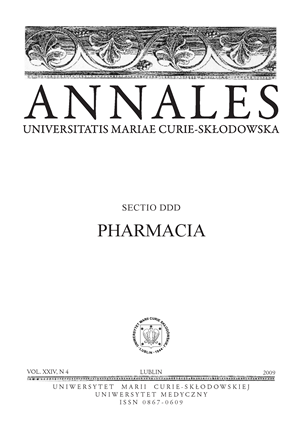Urinary glycosaminoglycans excretion in diabetic patients
Abstract
GAG are vital components of glomerular basement membranes and they play an important role in their molecular organization and function. In search of an early indicator of glomerular damages in patients with diabetes, it was decided to evaluate changes in urinary GAG excretion as a possible useful marker of the development of diabetic nephropathy. The aim of the conducted study was to find differences in urinary GAG excretion in patients with diabetes in comparison to the control group, to assess the infl uence of the degree of metabolic control on urinary GAG excretion, and to evaluate the possible usefulness of urinary GAG excretion as a laboratory test for diabetic nephropathy. The conducted studies suggest that in subjects with diabetes, changes in urinary GAG excretion are observed, which confirms changes in GAG metabolism in these patients. For complete determining of existing statistical correlations between urinary GAG excretion in patients with diabetes, study results require confirmation on a greater number of cases considering the duration of the disease and type of diabetes.
References
1. Cadaval R., Kohlman O., Michelacci Y.: Urinary excretion of glycosaminoglycans and albumin in experimental diabetes mellitus. Glycobiology, 10(2), 185, 2000.
2. De Muro et al.: A longitudinal evaluation of urinary glycosaminoglycans excretion in normoalbuminuric type 1 diabetics patients. Clin. Chem. Lab. Med., 44, 561, 2006.
3. Gambaro G., van Der Woude J.: Glycosaminoglycans: Use in treatment of Diabetic Nephropathy. J. Am. Soc. Nephrol., 11, 359, 2000.
4. Hurst R. E. : Structure, function, and pathology of proteoglycans and glycosaminoglycans in the urinary tract. World Journal of Urology, 3, 12, 1994.
5. Juret ic D., Krajnovic V., Bajalo L.: Altered distribution of urinary glycosaminoglycans in diabetic subjects. Acta Diabetol., 39, 123, 2002.
6. Kaznowska-Bystryk I. et al.: Changes in the excretion of glycosaminoglycans with urine in patients with glomerular disease. Annales UMCS, Sectio DDD, vol. XX, 35, 2007.
7. Lewis J. E., Xu X.: Abnormal Glomerular Permeability Characteristics in Diabetic Nephropathy. Diabetes Care, 31, 202, 2008.
8. McAuliffe A. V. et al.: Urinary Glycosaminoglycan Excretion in NIDDM Subjects: Its Relationship to Albuminura. Diabetic Medicine, 13 (8), 758, 1996.
9. Perez-Blanco F. et al.: Urinary Excretion of Glycosaminoglycans in Patients with early Diabetic Nephropathy. Nephron, 73, 344, 1996.
10. Prydz K., Dalen K. T: Synthesis and sorting of proteoglycans. Journal of Cell Science, 113, 193, 2000.
11. Tuomi T.: Type 1 and type 2 Diabetes-What do they have in common? Diabetes, Vol. 54, Supplement 2, 40, 2005.
12. Vilar R.E. et al.: Nitric oxide degradation of heparin and heparan sulfate. Biochem. J., 324, 473, 1997.
13. Yokoyama H. et al.: Serum and urinary concentrations of heparan sulfate in patients with diabetic nephropathy. Kidney International, 56, 650, 1999.
Downloads
Published
Issue
Section
License
Copyright (c) 2009 Authors

This work is licensed under a Creative Commons Attribution-NonCommercial-NoDerivatives 3.0 Unported License.


